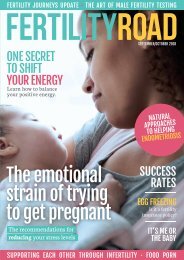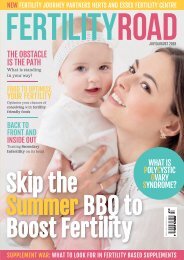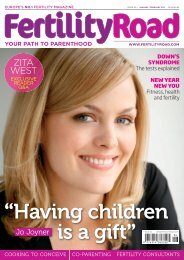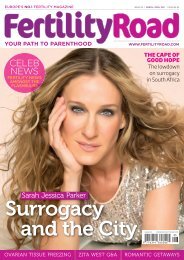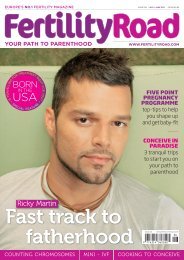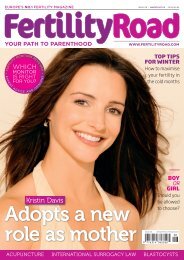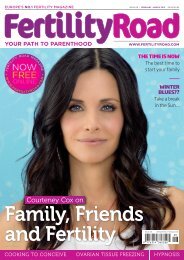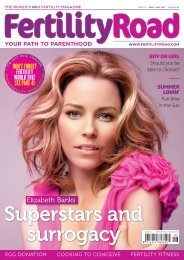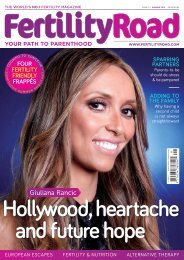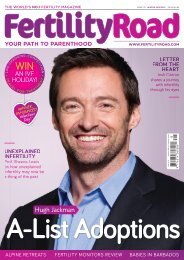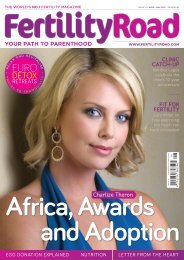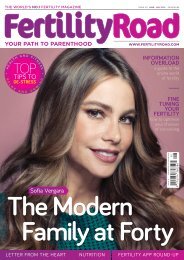Fertility Road Issue 03
You also want an ePaper? Increase the reach of your titles
YUMPU automatically turns print PDFs into web optimized ePapers that Google loves.
She is a fertility expert who has transformed the way millions of<br />
Americans think about their bodies. Across a generation’s span,<br />
where science and technology has left remarkable, dazzling<br />
imprints on fertility, Toni Weschler’s impact has been profound.<br />
Profiled now alongside the modern greats of reproductive<br />
communication, she gives an exclusive interview to<br />
<strong>Fertility</strong> <strong>Road</strong> magazine...<br />
TEACHER:<br />
TONI<br />
Sadly, a modern education still leaves women<br />
in the dark about their own bodies. We now<br />
have a generation of women in their 30s and<br />
40s who were taught nothing whatsoever<br />
about their fertility and have not the slightest clue<br />
about how the female reproductive system works.<br />
Essential facts every woman should know - for example<br />
that it’s possible to predict your next period if you know<br />
when you ovulated because the luteal (post-ovulation)<br />
phase has a consistent length in each woman, while<br />
the follicular (pre-ovulation) phase varies each cycle; or<br />
that cervical mucus with an ‘egg white’ appearance is a<br />
healthy sign of high fertility - were simply not included<br />
in our school ‘sex education’ lessons.<br />
Women today have left conceiving much later, and<br />
when we finally stop taking the pill to get pregnant, we<br />
suddenly realise we know nothing about our natural<br />
cycles. Tragically, we usually only come to understand<br />
our own biology at a late stage - when often, the time<br />
pressures are starting to become unbearable.<br />
In this era when women want to know as much as<br />
possible about their bodies, the new science of fertility<br />
awareness, made available with the advent of the<br />
digital thermometer in the 1970s, is more popular than<br />
ever. Our mothers are mystified to see our carefully<br />
plotted graphs. “It was so different in the 70s,” Suzanne,<br />
a 69-year-old writer, recalls. “We were vaguely aware<br />
the middle of the month was fertile, but getting pregnant<br />
just happened; we didn’t try.”<br />
But women trying to conceive today are older than ever<br />
before, desperate for knowledge so we can understand our<br />
natural cycles and maximise our chances of conceiving,<br />
fast - which is why modern women are getting hooked<br />
on the fertility awareness movement, the bible of which<br />
is the super-selling book Taking Charge of Your <strong>Fertility</strong><br />
by American Toni Weschler. Published in 1995, the book<br />
was the first to explain - in amazing detail - how to get<br />
pregnant by monitoring and recording on a chart the<br />
body’s daily fertility signs, including waking temperature,<br />
which rises after ovulation; cervical fluid (dry in infertile<br />
times of the month, increasingly creamy and then like egg<br />
white as you approach ovulation); and cervical position.<br />
And although these facts are now all over the internet<br />
and other fertility books, the fact remains that TCOYF<br />
explains them in the most comprehensive and authoritative<br />
detail - it’s still the biggest and the best manual for understanding<br />
your fertility. The book is currently ranked at<br />
number three out of the nearly 19 million published<br />
books sold on Amazon.com when it comes to customer<br />
ratings (trumped only by two Harry Potter novels). But<br />
that’s not down to marketing or publicity - TCOYF remains<br />
an underground, word-of-mouth fertility phenomenon. »<br />
www.fertilityroad.com<br />
25



